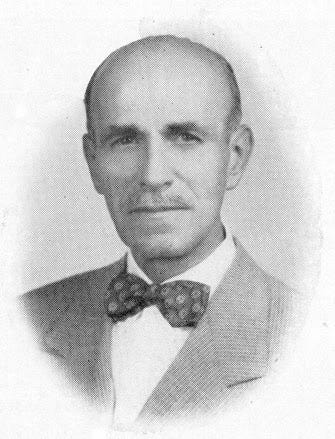The occult detective sub-genre of the mystery tale began its long life (afterlife?) in Great Britain during the late Victorian era. Inspired by the adventures of Sherlock Holmes and the ever-faithful Dr. Watson, occult detectives like Algernon Blackwood’s Dr. John Silence and William Hope Hodgson’s Carnacki brought ratiocination to the world of spooks and specters. Rather than hunt down mere blackmailers, occult detectives pursue ancient ghosts on Irish estates or try to break medieval curses. When the game is afoot for them, nightmares, mist, and screams follow behind.
During the heyday of Weird Tales magazine in the 1920s and ‘30s, one of the most popular characters was Dr. Jules de Grandin. An occult detective extraordinaire, almost one hundred de Grandin stories ran in Weird Tales from 1925 until 1951. Readers loved them, and Weird Tales often received more mail about the de Grandin yarns than any other stories. As one article notes, de Grandin was far more popular with the magazine’s faithful than either H.P. Lovecraft or Robert E. Howard. Howard had a distaste for detective fiction, so probably disliked de Grandin. Lovecraft, however, spent his boyhood pretending to be a member of Sherlock Holmes’s sleuthing gang and was deeply influenced by Sir Arthur Conan Doyle’s stories, so maybe he had a soft spot for de Grandin. Either way, except for in the arena of critical reception and cultural relevancy, de Grandin beat Howard and Lovecraft every time.
Dr. Jules de Grandin was the creation of author Seabury Quinn (1889-1969). Quinn was born less than a year before Lovecraft but grew up many miles away in Washington, D.C. His life seems to have been a respectable one— he graduated from the National University School of Law in 1910 and was admitted to the District of Columbia Bar in the same year. Quinn served in the U.S. Army during World War I, and, upon returning Stateside, landed a job as an editor for publications specializing in medical jurisprudence. The only obvious trace of weirdness in Quinn’s life was his career specialty: mortuary law. While penning de Grandin stories, which so often involved dead and/or reanimated individuals, Quinn was considered one of America’s foremost experts on the legal ins and outs of mortuaries.
Dr. de Grandin is without question Quinn’s most memorable character. De Grandin is described in the stories as a blonde man-of-action with a luxurious mustache and a proclivity towards fussiness in sartorial matters. De Grandin likes to pepper his English with French exclamations and expressions, which is natural given that de Grandin is a French national. Readers of speculative fiction should by now recognize that de Grandin was modeled off of Agatha Christie’s Belgian detective, Hercule Poirot. De Grandin and Poirot have similar backstories, with both men being veterans of espionage and intelligence work prior to becoming private eyes. However, de Grandin remains a member of the French Sûreté throughout the stories, plus he is a medical doctor to boot. De Grandin is also much more likely to use his fists than the rotund Poirot. The most obvious difference between the two is the fact that de Grandin battles monsters alongside his friend and chronicler, Dr. Trowbridge.
Initially the de Grandin stories took place all over the world, but when Quinn recognized that the series was destined for the long haul, he settled down. The vast majority of the de Grandin tales take place in the fictional community of Harrisonville, New Jersey. Despite its quaint exterior and distance from the bustling metropolis of New York, Harrisonville is prone to all sorts of horrors, from white slavery rings to vampire and werewolf attacks. De Grandin and Dr. Trowbridge are the only ones capable of defeating such evil. De Grandin is something of a superman, as he is not only well-versed in occult literature, but he is also a capable swordsman and shooter.
Although the readers preferred them to “The Call of Cthulhu” or the deeds of Solomon Kane, the de Grandin stories are not as polished or complex as many of their peers in Weird Tales. Quinn wrote for profit (although he was certainly wealthier than most of his pulp contemporaries), and many of the de Grandin yarns feel rushed. Quinn recycled plots and resolutions regularly, plus his supporting characters are so often one-dimensional stereotypes. Still, when enjoyed for what they are, the de Grandin tales must be recognized as pure, unadulterated fun. Quinn composed punchy prose, with action always first and foremost. The best de Grandin tales spare no expense for absurdity either. In “The Horror on the Links,” a private country club is terrorized by what appears at first to be a rampaging primate. “The Serpent Woman” makes some mileage out of the Jersey Devil myth, while “The Isle of Missing Ships” takes place in the South Seas on an island infested with cannibals. For the most part, familiar monstrosities like vampires and ghosts populate the de Grandin stories. This gives them a comfortable and cozy air not unlike a good Christie detective novel. De Grandin is perfect fare for a Sunday afternoon, which is downright odd for something out of Weird Tales.
Those interested should celebrate the fact that the de Grandin stories have been compiled and released in handsome volumes by Simon & Schuster. There is no better time than now to travel to Harrisonville and meet the good doctor. You are guaranteed a good time, even if things do get bloody on occasion. But hey, it’s Jersey.






